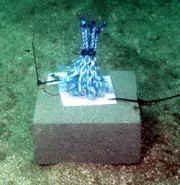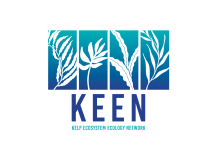Ecklonia radiata
Type of resources
Topics
Keywords
Contact for the resource
Provided by
Years
-
Data were collected from 28 artificial reefs varying in size and supporting different densities of transplanted kelp (Ecklonia radiata). We used rope fibre habitats (RFHs) attached to the benthos of the reefs and destructive sampling of understory algae to collect data on epifaunal invertebrates that naturally colonised the reefs (e.g. secondary productivity, species richness, Shannon diversity). The goal of the research was to understand how kelp structure influences the biodiversity and secondary productivity of epifauna.
-
The abundance of macroinvertebrates associated with 28 experimental artificial reefs supporting different patch sizes and density of kelp (Ecklonia radiata) off Maria Island, Tasmania. Macroinvertebrates were assessed by diver-based visual census conducted between November 2015 and December 2016. This data was collected to examine how the patch size and density of kelp influences the establishment of macroinvertebrate assemblages.
-
The recruitment of mussels and microphytobenthic (MPB) algae to 28 experimental artificial reefs supporting different patch sizes and density of kelp (Ecklonia radiata) off Maria Island, Tasmania. The recruitment of mussels was assessed using rope fibre habitats, and the recruitment of MPB algae was assessed using microscope slides, positioned across the artificial reef and collected in November 2015. These data were collected to examine how the patch size and density of kelp influences the establishment of MPB algae and mussels.
-

Community assembly in macrofauna communities developed in artificial kelp holdfasts was monitored at 1-month intervals over a 13 month period using a sampling design that used systematic patterns of temporal overlap and changes in start and collection dates. The hierarchical nature of the experimental design allowed several different approaches to analysis; by date of deployment and by date of collection of the artificial habitats, which enabled comparison of community assembly with and without the seasonal effects of the date of collection, and by community age to test whether there were alternative end-states to assembly depending on season or recruitment history.
-
Sea urchins have the capacity to destructively overgraze kelp beds and cause a wholesale shift to an alternative and stable ‘urchin barren’ state. However, their destructive grazing behaviour can be highly labile and contingent on behavioural shifts at the individual and local population level. Changes in supply of allochthonous food sources, i.e. availability of drift-kelp, is often suggested as a proximate trigger of change in sea urchin grazing behaviour, yet field tests of this hypothesis are rare. Here we conduct a suite of in situ behavioural surveys and manipulative experiments within kelp beds and on urchin barrens to examine foraging movements and evidence for a behavioural switch to an overgrazing mode by the Australian sea urchin Heliocidaris erythrogramma (Echinometridae). Tracking of urchins using time-lapse photography revealed urchin foraging to broadly conform to a random-walk-model within both kelp beds and on barren grounds, while at the individual level there was a tendency towards local ‘homing’ to proximate crevices. However, consistent with locally observed ‘mobile feeding fronts’ that can develop at the barrens-kelp interface, urchins were experimentally inducible to show directional movement toward newly available kelp. Furthermore, field assays revealed urchin grazing rates to be high on both simulated drift-kelp and attached kelp thalli on barren grounds, however drift-kelp but not attached kelp was consumed at high rates within kelp beds. Time-lapse tracking of urchin foraging before/ after the controlled addition of drift-kelp on barrens revealed a reduction in foraging movement across the reef surface when drift-kelp was captured. Collectively results indicate that the availability of drift-kelp is a pivotal trigger in determining urchin feeding modes, which is demonstrably passive and cryptic in the presence of a ready supply of drift-kelp. Recovery of kelp beds therefore appears possible if a sustained influx of drift-kelp was to inundate urchin barrens, particularly on reefs where local urchin densities and where grazing pressure is close to the threshold enabling kelp bed recovery.
-
Biogenic marine habitats are increasingly threatened by a multitude of human impacts, and temperate coasts in particular are exposed to progressively more intense and frequent anthropogenic stressors. In this study, the single and multiple effects of the urban stressors of nutrification and sedimentation on kelp bed communities were examined within Australia’s largest urbanised embayment (Port Phillip Bay, Victoria). Within this system, grazing by sea urchins (Heliocidaris erythrogramma) plays an important role in structuring reef communities by overgrazing kelp beds and maintaining an alternative and stable urchin barrens state. It is therefore important to explore the effects of urban stressors on kelp bed dynamics related to urchin abundance, and test the relative strengths of bottom-up and / or physical drivers (e.g. elevated nutrients and sediment) versus top-down (e.g. urchin grazing) forces on kelp bed community structure. The interactions of these drivers were assessed to determine whether their combination has synergistic, antagonistic, or additive effects on kelp beds. It was found that kelp responds positively to nutrient enhancement, but when combined with enhanced abundance of grazing sea urchins, the local positive effect of nutrient enhancement is overwhelmed by the negative effect of increased herbivory. Turf-forming algae behaved very differently, showing no detectable response to nutrification, yet showing a positive response to urchins, apparently mediated by overgrazing of canopy-forming algae that limit turf development. No direct effects of enhanced sediment load (at twice the ambient load) were found on intact kelp beds. Collectively, the results demonstrate that the ‘top-down’ control of urchin grazing locally overwhelms the positive ‘bottom-up’ effect of nutrient enhancement, and that intact kelp beds demonstrate resilience to direct impacts of urban stressors.
-
Data accompanying Layton et al. 2019, Resilience and stability of kelp forests: the importance of patch dynamics and environment-engineer feedbacks. PLOS ONE. To explore how resilience and stability of kelp habitats is influenced by this habitat degradation, we created an array of patch reefs of various sizes and supporting adult Ecklonia radiata kelp transplanted at different densities. This enabled testing of how sub-canopy abiotic conditions change with reductions in patch size and adult kelp density, and how this influenced demographic processes of microscopic and macroscopic juvenile kelp.
-
Data is PCR amplification results of southern rock lobster (Jasus edwardsii) faecal material tested for sea urchin DNA (using unique primers for Centrostephanus rodgersii and Heliocidaris erythrogramma) in an attempt to determine in situ rates of consumption of sea urchins by lobsters. An efficient and non-lethal method was used to source and screen lobster faecal samples for the presence of DNA from ecologically important sea urchins. Lobster faecal samples were collected from trap caught specimens sourced in winter & summer seasons over 2 years (2009-2011) within two no-take research reserves; declared specifically for the purpose of rebuilding large predatory-capable lobsters to assess the potential for predator-driven remediation of kelp beds on rocky reefs extensively overgrazed by sea urchins (North Eastern Tasmania) and reefs showing initial signs of overgrazing (South Eastern Tasmania). Data for molecular assays showed high variability in the proportion of lobsters testing positive to sea urchins, with significant variability detected across different years and seasons but this was found to vary depending on different lobster size-classes. Sea urchin DNA was also amplifiable from sediments and urchin faeces collected from the reef surface where urchins occurred in high abundance. Furthermore, positive sea urchin DNA assays were obtainable from lobster faeces after lobsteres were fed sediment and urchin faecal material. Rates of predation obtained with genetics tests can also be compared to independent rates of urchin losses given known lobster abundances within research reserves (and at control sites). Data of changes in urchin abundances and lobster abundances are therefore also lodged as part of this record.
-
The long spined sea urchin Centrostephanus rodgersii (Diadematidae) has recently undergone poleward range expansion to eastern Tasmania (southeast Australia). This species is associated with barrens habitat which has been grazed free of macroalgae, and therefore has potentially important consequences for reef structure and biodiversity. This study used urchin removal experiments from barrens patches in eastern Tasmania to monitor the subsequent response of the macroalgae relative to unmanipulated barrens patches. In removal patches, there was a rapid proliferation of canopy-forming macroalgae (Ecklonia radiata and Phyllospora comosa), and within 24 months the algae community structure had converged with that of nearby areas without urchins. Faunal species richness was comparatively low in barrens habitat, with C. rodgersii grazing activity resulting in an estimated minimum net loss of approximately 150 taxa compared with intact macroalgal habitats.
-

This global meta-analysis documents data from underwater visual surveys used to determine the effect of kelp bed disturbance and canopy density on the abundance and structure of fish communities. Spatial, temporal and ontogenetic variability of many key fish species was examined at various levels of kelp disturbance at sites spanning a global temperate distribution. Rocky reef habitats and fisheries management regimes of sites were also examined as covariates. This data spans from 1984 to present. Note that Emma has completely fabricated this abstract, and requires direct input from KEEN.
 TemperateReefBase Geonetwork Catalogue
TemperateReefBase Geonetwork Catalogue